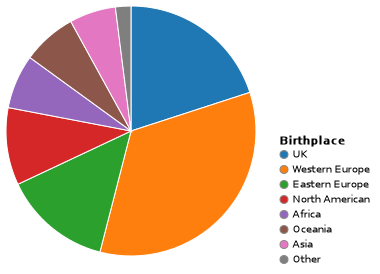Other White
The term Other White is a classification of ethnicity in the United Kingdom and has been used in documents such as the 2011 UK Census to describe people who self-identify as white persons who are not of the English, Welsh, Scottish or Irish ethnic groupings. The category does not comprise a single ethnic group but is instead a method of identification for white people who are not represented by other white census categories. This means that the Other White group contains a diverse collection of people with different countries of birth, languages and religions. Along with White British and White Irish, the category does not appear in Northern Ireland, where only one single "White" classification was presented to respondents.[1]
The categorisation was primarily intended to cover people with ancestry from Continental Europe, with the largest of these ethnic groups in the country being Poles, Germans, Romanians, Italians and the French.[2][3]
Demographics

In the 2001 UK Census, the majority of people living in England and Wales ticking the 'Other White' ethnic group specified their ethnicity as European.[4] Four out of five of the 'Other White' category (i.e. not British or Irish) were born overseas. A third were born in a Western European country other than the UK, and one in seven were born in an Eastern European country.[4] The Other White group is largely of working age, with only one in ten aged over 65 and one in seven under 16 at the time of the 2001 census. This does vary according to the stated country of birth, with people born in the UK being disproportionately young. Polish and Italian respondents had a larger proportion of over 65s,[4] which reflects the migration of Poles and Italians to Britain after the Second World War. A wide number of religions are represented in the Other White group. In the census, the largest faith group, 63 per cent, identified themselves as Christian, with 16 per cent defining themselves as without religion, nine per cent as Muslims, and two per cent as Jewish.[4]
See also
- Austrians in the United Kingdom
- Baltic people in the United Kingdom
- Czechs in the United Kingdom
- Dutch people in the United Kingdom
- Germans in the United Kingdom
- Greeks in the United Kingdom
- Italians in the United Kingdom
- History of the Jews in the United Kingdom
- Poles in the United Kingdom
- Portuguese in the United Kingdom
- Russians in the United Kingdom
- Scandinavian migration to Britain
- Slovenes in the United Kingdom
- Spaniards in the United Kingdom
- Swedes in the United Kingdom
- Americans in the United Kingdom
- Canadians in the United Kingdom
- South Africans in the United Kingdom
- Australians in the United Kingdom
- New Zealanders in the United Kingdom
References
- ↑ "Harmonised Concepts and Questions for Social Data Sources: Primary Standards – Ethnic Group" (PDF). Office for National Statistics. April 2008. Archived from the original (PDF) on 7 January 2010. Retrieved 21 August 2010.
- ↑ 2011 Census: KS202EW National identity, local authorities in England and Wales, Accessed 22 December 2012
- ↑ "Population of the UK by Country of Birth and Nationality: 2015". Office for National Statistics – Table 2: Five most common non-UK countries of birth and non-British nationalities for usual residents of the UK, 2017. Retrieved 9 June 2017.
- 1 2 3 4 5 Gardener, David; Connolly, Helen (October 2005). "Who are the 'Other' ethnic groups?" (PDF). Office for National Statistics. Archived from the original (PDF) on May 28, 2008. Retrieved 22 June 2008.